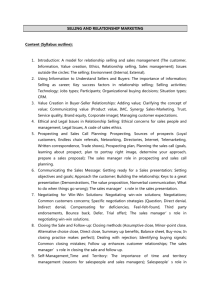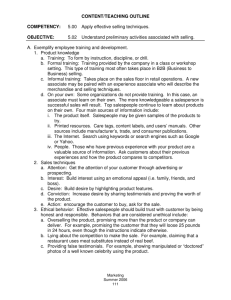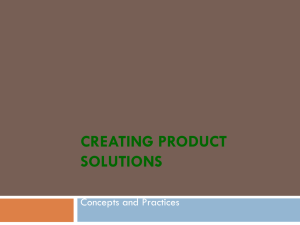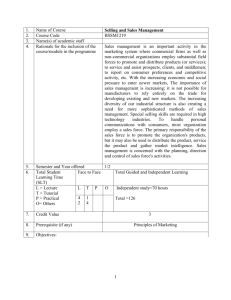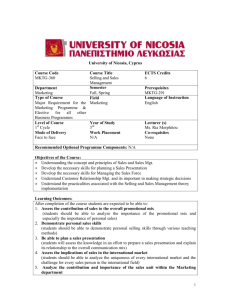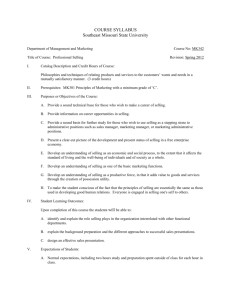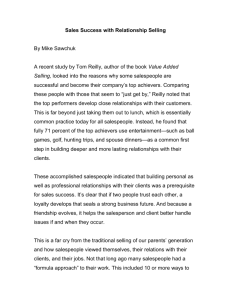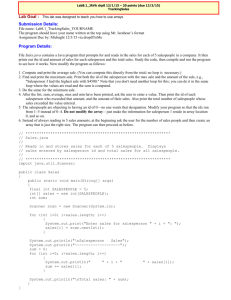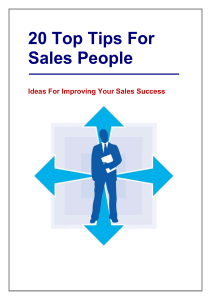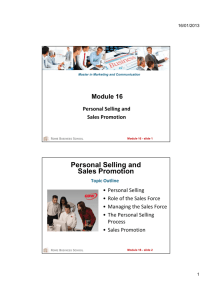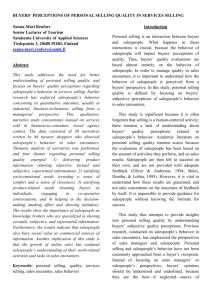O PREDMETU
advertisement
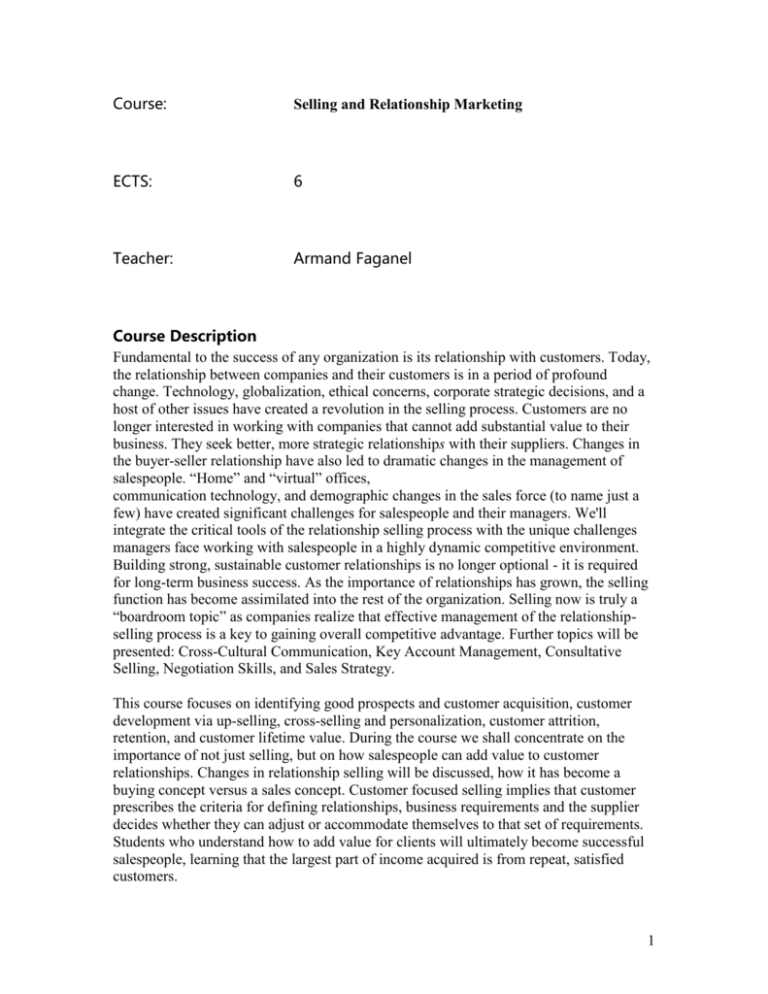
Course: Selling and Relationship Marketing ECTS: 6 Teacher: Armand Faganel Course Description Fundamental to the success of any organization is its relationship with customers. Today, the relationship between companies and their customers is in a period of profound change. Technology, globalization, ethical concerns, corporate strategic decisions, and a host of other issues have created a revolution in the selling process. Customers are no longer interested in working with companies that cannot add substantial value to their business. They seek better, more strategic relationships with their suppliers. Changes in the buyer-seller relationship have also led to dramatic changes in the management of salespeople. “Home” and “virtual” offices, communication technology, and demographic changes in the sales force (to name just a few) have created significant challenges for salespeople and their managers. We'll integrate the critical tools of the relationship selling process with the unique challenges managers face working with salespeople in a highly dynamic competitive environment. Building strong, sustainable customer relationships is no longer optional - it is required for long-term business success. As the importance of relationships has grown, the selling function has become assimilated into the rest of the organization. Selling now is truly a “boardroom topic” as companies realize that effective management of the relationshipselling process is a key to gaining overall competitive advantage. Further topics will be presented: Cross-Cultural Communication, Key Account Management, Consultative Selling, Negotiation Skills, and Sales Strategy. This course focuses on identifying good prospects and customer acquisition, customer development via up-selling, cross-selling and personalization, customer attrition, retention, and customer lifetime value. During the course we shall concentrate on the importance of not just selling, but on how salespeople can add value to customer relationships. Changes in relationship selling will be discussed, how it has become a buying concept versus a sales concept. Customer focused selling implies that customer prescribes the criteria for defining relationships, business requirements and the supplier decides whether they can adjust or accommodate themselves to that set of requirements. Students who understand how to add value for clients will ultimately become successful salespeople, learning that the largest part of income acquired is from repeat, satisfied customers. 1 Course timetable Class 1 Class 2 Class 3 Class 4 Class 5 Class 6 Class 7 Class 8 Objectives Introduction: A model for relationship selling and sales management (The customer, Information, Value creation, Ethics, Relationship selling, Sales management); Issues outside the circles: The selling; Environment (Internal, External). Using Information to Understand Sellers and Buyers: The importance of information; Selling as career; Key success factors in relationship selling; Selling activities; Technology; Jobs types; Participants; Organizational buying decisions; Situation types; CRM Value Creation in Buyer-Seller Relationships: Adding value; Clarifying the concept of value; Communicating value (Product value, IMC, Synergy Sales-Marketing, Trust, Service quality, Brand equity, Corporate image); Managing customer expectations Ethical and Legal Issues in Relationship Selling: Ethical concerns for sales people and management, Legal Issues, A code of sales ethics. Prospecting and Sales Call Planning: Prospecting, Sources of prospects (Loyal customers, Endless chain referrals, Networking, Directories, Internet, Telemarketing, Written correspondence, Trade shows), Prospecting plan, Planning the sales call (goals, learning about prospect, plan to portray right image, determine your approach, prepare a sales proposal); The sales manager role in prospecting and sales call planning Communicating the Sales Message: Getting ready for a Sales presentation; Setting objectives and goals; Approach the customer; Building the relationship; Keys to a great presentation (Demonstrations, The value proposition, Nonverbal communication, What to do when things go wrong); The sales manager’s role in the sales presentation. Negotiating for Win-Win Solutions: Negotiating win-win solutions; Negotiations; Common customers concerns; Specific negotiation strategies (Question, Direct denial, Indirect denial, Compensating for deficiencies, Feel-feltfound, Third party endorsements, Bounce back, Defer, Trial offer); The sales manager’s role in negotiating win-win solutions. Closing the Sale and Follow-up: Closing methods (Assumptive close, Minor-point close, Alternative choice close, Direct close, Summary up benefits, Balance sheet, Buy-now, In closing practice makes perfect); Dealing with 2 Class 9 Class 10 Class 11 Class 12 Class 13 Class 14 rejection; Identifying buying signals; Common closing mistakes; Follow up enhances customer relationships; The sales manager’s role in closing the sale and follow up. Self-Management_Time and Territory: The importance of time and territory management (reasons for salespeople and sales managers); Salespeople’s role in time and territory management; Sales manager’s role in time and territory management Salesperson Performance_Behavior, Motivation, and Role Perceptions: Salespersons performance (Role perceptions, sales aptitude, Sales skill levels, Motivation, Rewards, Satisfaction); How salespeople influence performance; How managers influence performance. Recruiting and Selecting Salespeople: Recruiting and selection issues (Establish responsibility, Analyze job and determine selection, Criteria, Find and attract applicants, Develop and apply selection procedures); Salespeople’s role in recruitment. Training Salespeople for Sales Success: Objectives of sales training; Developing successful sales training programs; Training needs with time; Sales training topics; Sales training methods; Measuring the costs and benefits of sales training; The salesperson's role in sals training Salesperson Compensation and Incentives: Overview of compensations and incentives; Stratight salary, straight commision and combination plans; Sales contests; Nonfinancial rewards; Expense accounts; Making compensation and incetive programs work; Deciding on the mix and level of compensation. Evaluating Salesperson Performance: Peformance vs. effectiveness; Objective measures of performance; Subjective measures of performance; 360-Degree performance feedback. Learning Outcomes Students should be able to develop subject specific competencies: To build their knowledge of a rapidly emerging marketing arena - customercentric marketing - which some claim is the beginning of a new business. To recognize that there are often two sides to customer-centric marketing or customer relationship management (CRM) - what is good for the firm may not always be good for the customer, and that what is desirable from the customer’s point of view is not always desirable for the firm. To identify and examin in detail each of the elements in the relationship-selling process. 3 To use critical precursors to the relationship-selling process - using information to understand sellers and buyers and the concept of value creation and communication, both of which are central to the buyer-seller relationship. Understand fundamental sales management concepts and learn how to assess different skills, necessary for successful selling and relationship marketing. Course Requirements Learning and teaching methods frontal teaching work in small groups of students lecturing discusion working with texts students' independent work case studies role play Assessment (weights in %) Class participation - 10 % Written seminar - 40 % Final examination - 50 % Required literature Johnston, Mark W. and Greg W. Marshall. 2008. Relationship selling, (2nd Edition). Boston: McGraw-Hill Irwin. Recommended readings Jobber, D. and G. Lancaster. Selling and Sales Management (7th Edition), Harlow: Prentice Hall. Gummesson, E. 2008. Total Relationship Marketing, Third Edition: Marketing management, relationship strategy and CRM approaches for the network economy, Oxford: Butterworth-Heinemann. Berry, M.J.A. and G.S. Linoff. 2004. Data Mining Techniques: For Marketing, Sales, and Customer Relationship Management, John Willey and Sons. 4

